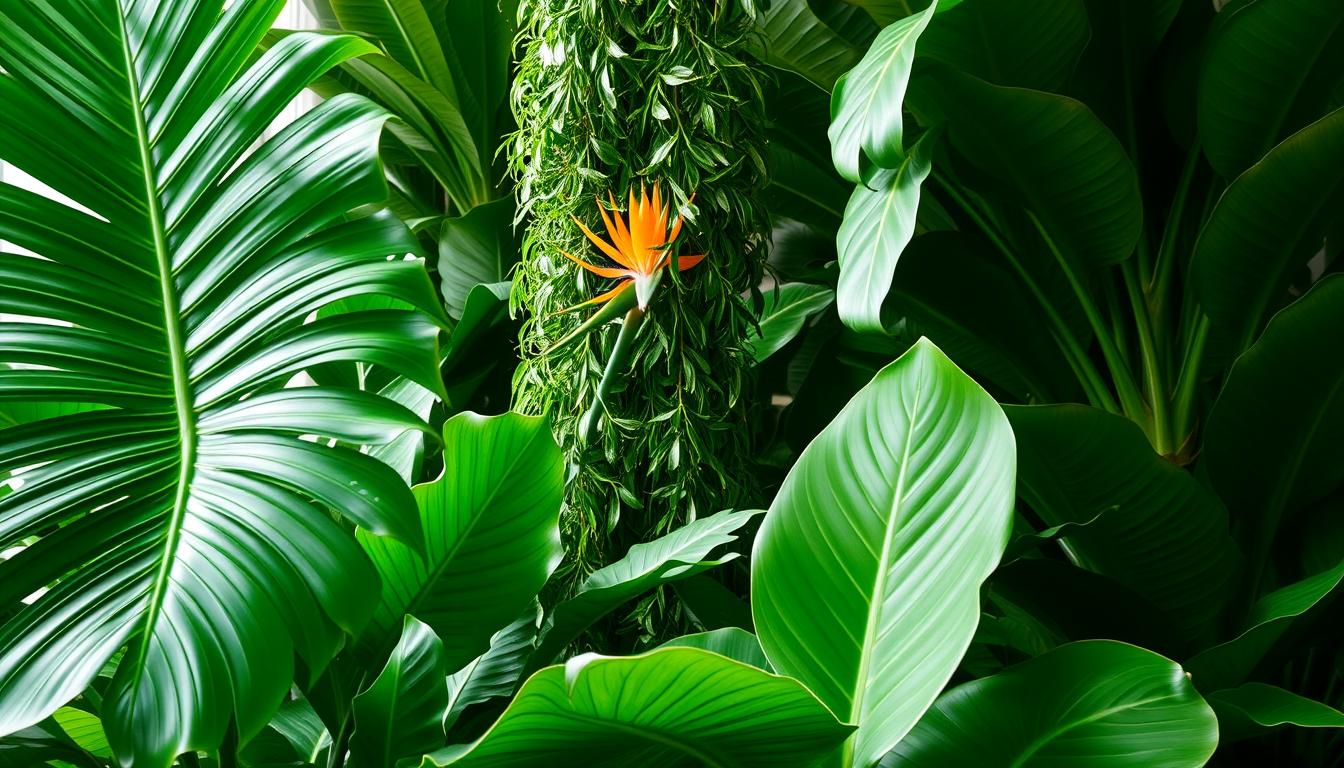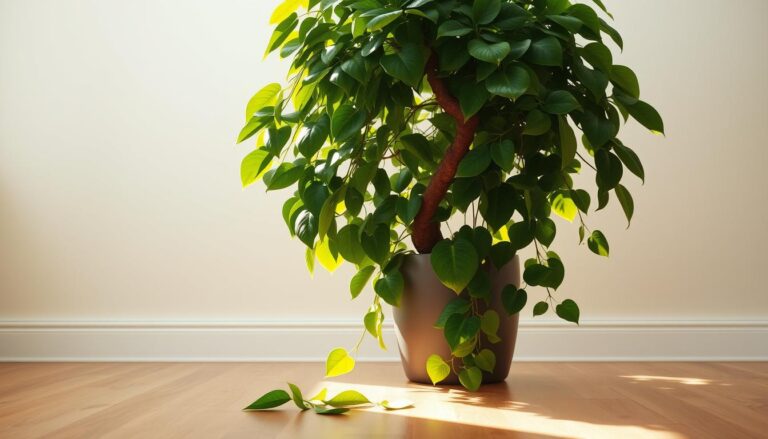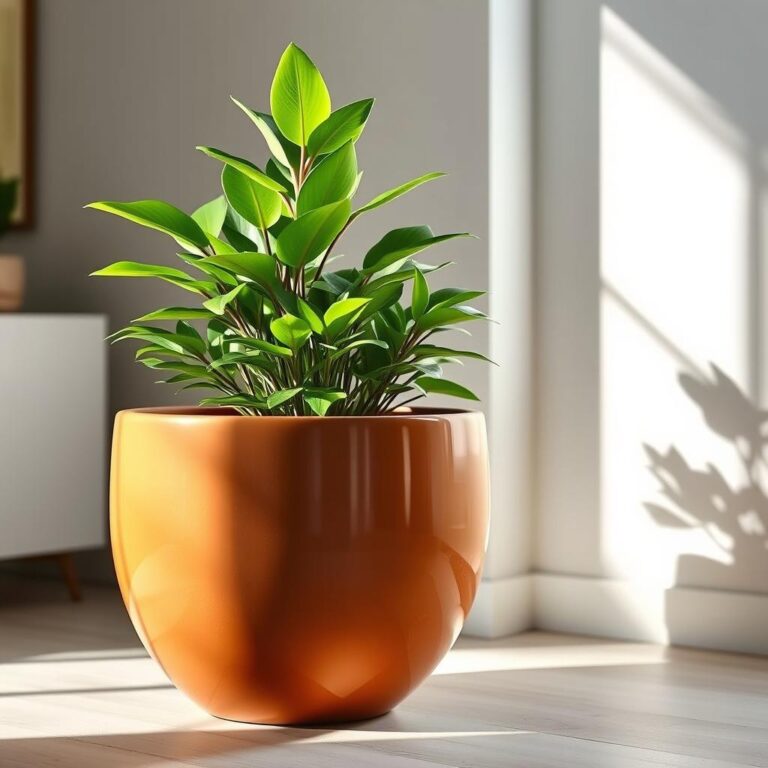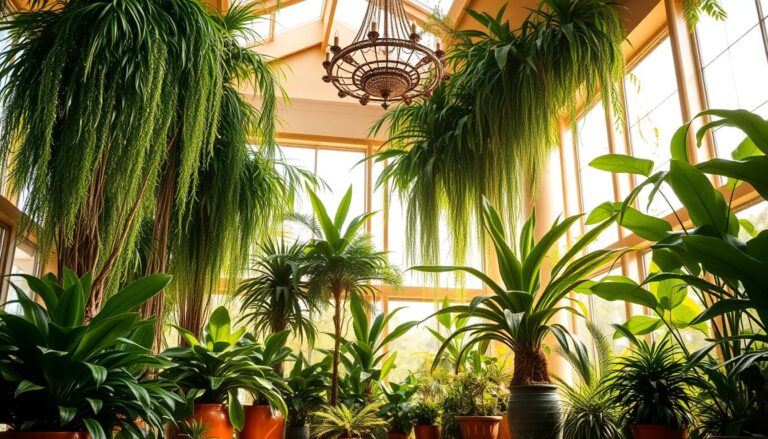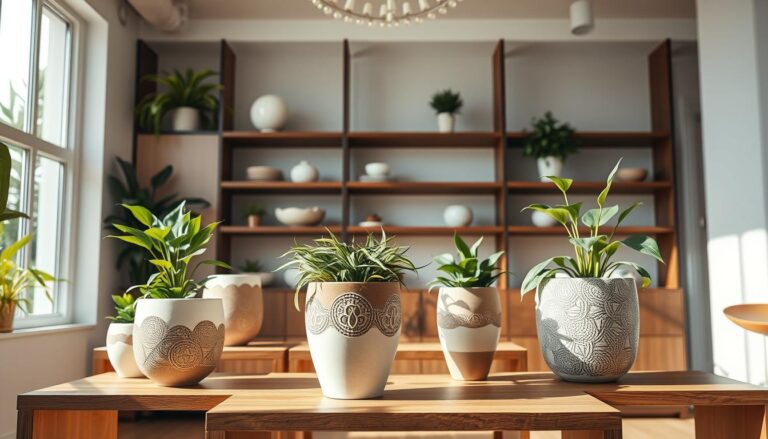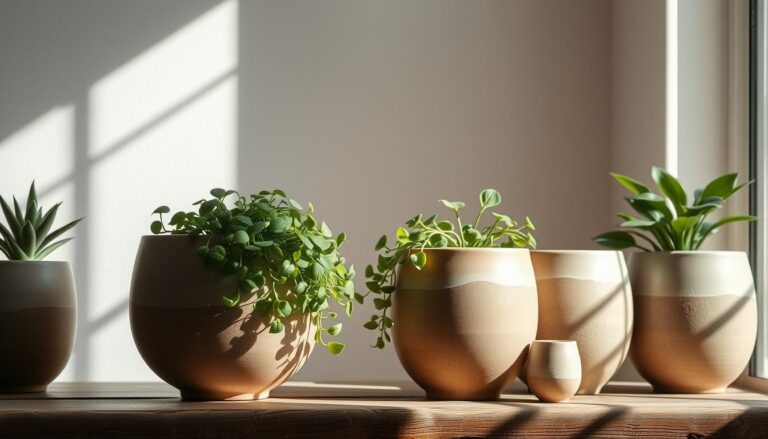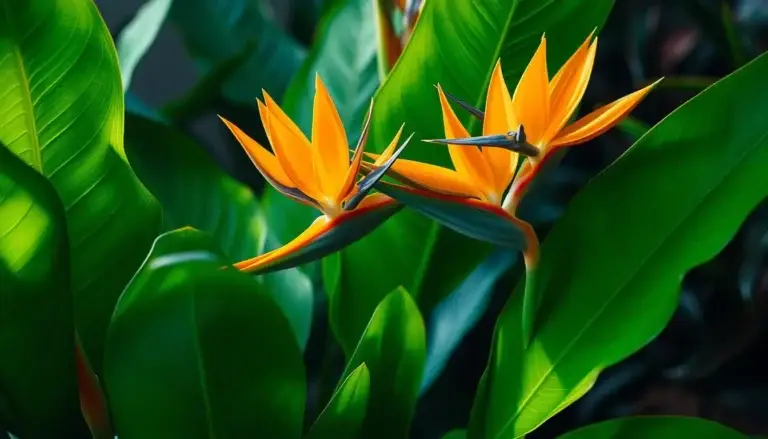Top House Plants with Impressive Foliage
Imagine walking into a room where vibrant, oversized leaves stretch toward the light, turning blank walls into living art. That’s the magic of creating your own indoor jungle. Whether you’re a seasoned plant parent or just starting out, statement-making foliage can transform your space from ordinary to extraordinary.
Take the Monstera deliciosa, for example. Its dramatic split leaves add instant texture to any corner. Or the Fiddle Leaf Fig, whose glossy green surfaces catch sunlight like nature’s own mirrors. These aren’t just decorations—they’re conversation starters that breathe life into your home.
But it’s not all about looks. Choosing the right species means balancing beauty with practicality. Most thrive in bright, indirect light and well-draining soil. A few, like the resilient elephant ear plant, even tolerate lower-light conditions. The key? Matching their needs to your environment.
Table of Contents
Ready to dive deeper? We’ll explore care routines that keep leaves lush, styling tricks for maximum effect, and trusted recommendations from horticulture experts. Your journey to a greener, more vibrant living space starts here.
Introduction to Big-Leaf House Plants
Step into a home where every corner bursts with natural grandeur through expansive greenery. These botanical giants do more than fill empty spaces—they redefine them. According to The Spruce, oversized foliage adds instant depth to rooms, turning flat surfaces into textured landscapes that invite exploration.
Setting the Scene for Your Indoor Jungle
Think of your space as a canvas where broad leaves create rhythm and flow. The Swiss cheese plant, with its fenestrated patterns, demonstrates how unique shapes break visual monotony. Layer different specimens at varying heights to mimic natural ecosystems. Place taller varieties near windows and compact types on side tables for dynamic contrast.
Why Big Foliage Makes a Statement
A single fiddle leaf specimen can anchor an entire room’s design. Its glossy surface reflects light, amplifying brightness without harsh glare. Proper care ensures leaves stay vibrant—rotate pots weekly for even sun exposure and wipe dust monthly.
“Large-leaf varieties act as living art installations,”
notes an interior design expert. When positioned strategically, they become focal points that spark curiosity and admiration.
House Plants with Big Leaves
Elevate your decor with specimens that boast dramatic, eye-catching foliage. The right selection transforms empty corners into tropical escapes while balancing form and function. Let’s explore standout varieties that deliver maximum visual impact.
Elephant ear steals the spotlight with dinner-plate-sized leaves reaching 3 feet long. As noted by The Spruce, this variety thrives in humid environments and chunky, well-draining soil. Pair it with Swiss cheese specimens—their signature holes create mesmerizing light patterns on nearby surfaces.
Bird of paradise adds architectural flair through banana-like leaves that fan out vertically. Contrast this with heart-shaped philodendron varieties whose glossy surfaces reflect sunlight. Each type demands specific conditions: most prefer bright indirect light, though some tolerate shaded areas.
Consider your room’s dimensions before choosing. Compact spaces suit smaller-leafed options like alocasia polly, while vaulted ceilings accommodate towering fiddle leaf figs. Outdoor patios can host these varieties seasonally, but indoor growth requires consistent humidity.
“Oversized foliage acts as nature’s sculpture, demanding attention without uttering a word.”
Upcoming sections break down care routines for each superstar. You’ll learn to maintain vibrant colors and prevent leaf drop—ensuring your green investments flourish year-round.
Benefits of Big Foliage in Your Indoor Space
Transform your living area into a sanctuary where form meets function through nature’s grand designs. Expansive greenery does more than occupy space—it elevates your environment through visual drama and cleaner air.
Enhancing Aesthetics and Decoration
The fiddle leaf fig reigns supreme in modern interiors, its tree-like structure adding vertical interest to empty corners. Positioned near east-facing windows, its broad surfaces catch morning light, casting soft shadows that animate walls. The Spruce notes this variety’s popularity stems from its ability to “anchor minimalist spaces with organic texture.”
Strategic placement matters. A single specimen over 5 feet tall creates an instant focal point, while groupings of varying heights mimic layered garden designs. Pair deep green varieties with neutral furniture for contrast, or use variegated types to brighten dim areas.
Improving Air Quality and Ambiance
NASA’s Clean Air Study reveals many large-leaf species filter toxins like formaldehyde. The rubber plant, for instance, removes airborne pollutants while releasing oxygen. This dual action enhances mental clarity and room freshness.
Humidity-loving varieties like bird of paradise also combat dry air. Their transpiration process adds moisture, reducing static electricity and respiratory irritation. Place these near seating areas to maximize their soothing effects.
| Benefit | Example | Key Feature |
|---|---|---|
| Visual Impact | Fiddle Leaf Fig | Grows up to 6 feet indoors |
| Air Purification | Snake Plant | Filters 107+ airborne toxins |
| Humidity Control | Elephant Ear | Releases 97% absorbed water |
“A well-placed fiddle leaf transforms empty space into curated art,”
For maximum effect, rotate specimens weekly to ensure even growth. Use plant stands to elevate shorter varieties, creating depth. Combine functional air-purifiers with decorative pieces to craft spaces that nurture both eyes and lungs.
Choosing the Perfect Big-Leaf House Plant for Your Home
What makes a bold botanical specimen thrive in your space? Three critical factors determine success: available room dimensions, light patterns, and your decor personality. Match these elements to species needs for greenery that grows healthier and looks intentional.
Factors to Consider: Space, Light, and Style
Measure your room’s height and floor area first. Bird of paradise stretches vertically, needing 8-foot ceilings for its banana-like leaves. Compact spaces suit alocasia varieties, which reach 3 feet tall. Avoid overcrowding—leave 2 feet between specimens for airflow.
Light dictates growth speed and leaf vibrancy. As Gardening Know How notes, plants like elephant ear crave bright indirect light but scorch in direct sun. North-facing rooms? Try cast iron specimens adapted to lower brightness.
Soil and water needs vary dramatically. Species commonly grown outdoors, like monstera, demand chunky mixes with perlite. Overwatering causes root rot—let the top inch dry before hydrating again.
| Factor | Example Plant | Requirement |
|---|---|---|
| Space | Bird of Paradise | 8+ ft vertical clearance |
| Light | Elephant Ear | Bright indirect, 6 hours/day |
| Style | Fiddle Leaf Fig | Modern minimalist decor |
“Select specimens that complement your room’s proportions—oversized leaves shouldn’t overwhelm furniture.”
Finally, align leaf shapes with your aesthetic. Broad, rounded varieties soften angular rooms, while spiky types add edge. With these guidelines, you’ll find greenery that elevates your home effortlessly.
Understanding Light Requirements for Big-Leaf Plants
Light shapes every leaf’s journey from sprout to showstopper. For species like Monstera and fiddle leaf specimens, proper exposure determines whether foliage thrives or barely survives. The Spruce confirms: “Bright indirect light fuels 90% of tropical varieties’ growth without scorching delicate surfaces.”
Direct vs. Indirect Light Explained
Direct sunlight beams straight onto surfaces—think south-facing windows at noon. This intensity often burns broad leaves, leaving crispy brown edges. Indirect light bounces off walls or filters through curtains, creating dappled patterns similar to forest canopies.
| Light Type | Examples | Best For |
|---|---|---|
| Direct | Zebra plant | 3-4 hours morning sun |
| Indirect | Fiddle leaf fig | 6+ hours filtered exposure |
Adjusting Your Home’s Lighting Conditions
Track how sunlight moves through your space. Use sheer curtains to diffuse harsh afternoon rays near west-facing windows. Rotate pots weekly so all sides receive equal energy. If natural light falls short, LED grow lights set 12 inches above foliage mimic tropical conditions.
“Leaf size and color intensity directly reflect light quality,”
notes a horticulturist from The Spruce. High humidity amplifies these effects—group specimens or use pebble trays to create microclimates. Test spots by observing leaves: yellowing signals excess sun, while leggy growth cries for more.
Soil and Watering Essentials for Big-Foliage House Plants
The secret to thriving foliage lies beneath the surface—where roots meet their foundation. According to The Spruce, specimens like Swiss cheese and elephant ear demand precise soil and hydration strategies to maintain their grandeur. Get this balance right, and you’ll unlock year-round vibrancy without constant fuss.
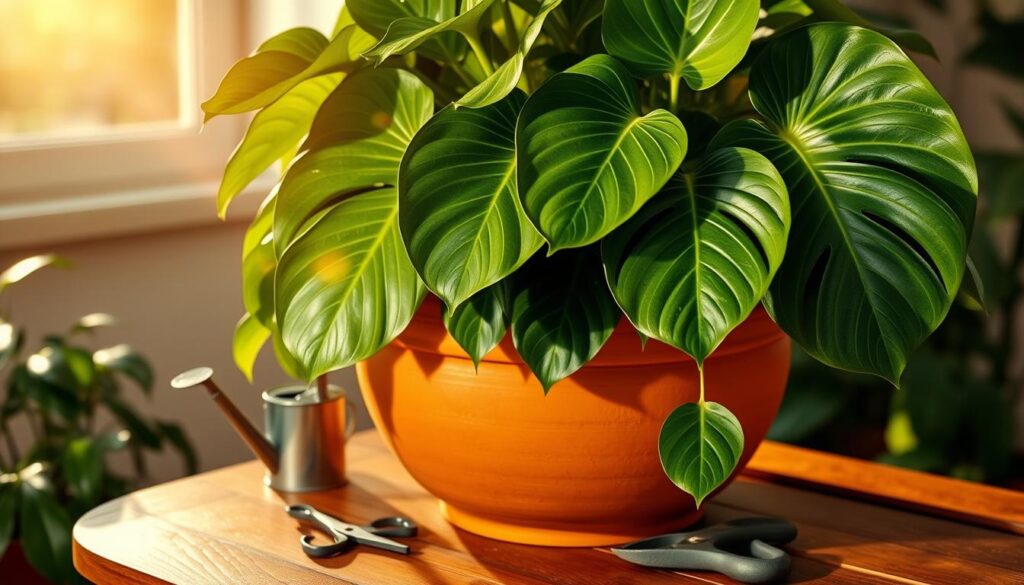
Selecting the Right Potting Medium
Start with a peat-rich mix blended with perlite or orchid bark. These ingredients create air pockets, preventing root suffocation in moisture-loving varieties. A chunky texture mimics tropical forest floors where many large-leaf species naturally grow.
For elephant ear, The Spruce recommends adding compost for nutrients. Avoid dense garden soil—it compacts over time, starving roots of oxygen. Repot every 12-18 months to refresh mineral content.
Watering Frequency and Techniques
Check moisture by sticking your finger two inches deep. Water only when dry, using room-temperature liquid to avoid shock. Tropical types prefer consistent dampness, while others thrive on brief dry spells.
Adjust routines seasonally: cut back in winter when growth slows. Use pots with drainage holes and empty saucers promptly.
“Overwatering drowns roots faster than underwatering,”
| Component | Benefit | Best For |
|---|---|---|
| Peat Moss | Retains moisture | Swiss cheese plant |
| Perlite | Improves drainage | Elephant ear |
| Orchid Bark | Prevents compaction | Mature specimens |
Group humidity-loving varieties on pebble trays to boost ambient moisture. Wipe leaves monthly to maximize photosynthesis—dust blocks light absorption essential for large-leaf health.
Popular Big-Leaf Plants and Their Unique Features
Certain specimens dominate interiors through sheer botanical presence. Their distinct silhouettes and growth habits offer diverse ways to elevate your decor while meeting practical needs.
Fiddle Leaf Fig and Monstera Deliciosa
The fiddle leaf fig commands attention with violin-shaped leaves that mature to 15 inches long. The Spruce confirms it thrives in bright indirect light, needing weekly rotation for balanced growth. Water when the topsoil dries—overhydration causes leaf drop.
Monstera deliciosa brings jungle drama through natural leaf holes called fenestrations. Its split foliage thrives in chunky soil mixes with perlite. This tropical giant can climb 8 feet tall, making it ideal for empty corners needing vertical interest.
Elephant Ear and African Mask Plant
Elephant ear varieties flaunt heart-shaped leaves spanning 3 feet wide. They demand high humidity (60%+) and moist soil, thriving near east-facing windows. Pair with pebble trays to maintain tropical conditions.
The African mask plant offers arrowhead-shaped foliage with silver veining. Unlike its sun-loving cousins, it prefers medium light and monthly fertilization. Its compact size suits shelves or side tables where bold patterns shine.
“These species transform spaces through contrasting textures—glossy against matte, smooth versus perforated.”
| Plant | Mature Height | Key Feature |
|---|---|---|
| Fiddle Leaf Fig | 6 ft | Glossy surface reflects light |
| Monstera | 8 ft | Natural leaf fenestrations |
| Elephant Ear | 5 ft | Dramatic heart-shaped foliage |
| African Mask | 2 ft | Metallic vein patterns |
Mix these varieties to create layered displays. Place taller specimens behind low-growing types for depth. Remember—each contributes uniquely to your indoor ecosystem through form and function.
Caring for Iconic Exotic House Plants
Nurturing exotic foliage requires precision and awareness of hidden challenges. While their bold forms captivate, species like the fiddle leaf fig demand tailored routines to prevent leaf drop and maintain vibrancy. The Spruce advises trimming yellowing leaves at the base to redirect energy to healthy growth—a practice that keeps your plant looking sculpted year-round.
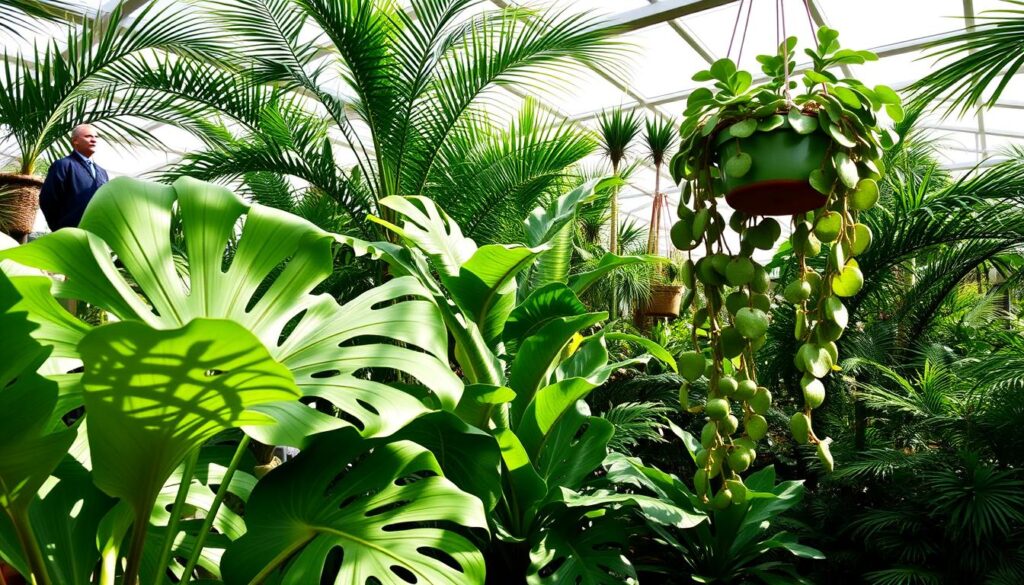
Maintenance Tips and Pruning Techniques
Sharp, sterilized shears are essential for clean cuts that prevent disease. For varieties like monstera, prune aerial roots sparingly to control size without stunting development. Rotate pots monthly to ensure even sun exposure, especially for light-sensitive specimens.
- Remove damaged foliage during spring to encourage summer growth
- Wipe leaves weekly with damp cloths to boost photosynthesis
- Adjust watering when temperatures fluctuate—less in winter
Handling Toxicity and Pet Safety
Many exotic plants, including elephant ear and African mask, contain irritants. Place these on high shelves or in hanging planters if you have curious pets.
“Even non-toxic varieties can cause digestive upset if ingested,”
warnsThe Spruce. For mixed households, consider pet-safe alternatives like prayer plants that offer similar drama without risks.
Create barriers using decorative screens or plant stands. Always wash hands after handling soil or pruning to avoid skin irritation. With thoughtful placement and routines, you’ll enjoy striking color and texture while keeping loved ones safe.
Managing Pests and Troubles for Your Indoor Foliage
Even the healthiest foliage can fall prey to unseen pests and environmental stressors. The Spruce reports that 68% of indoor plant issues stem from preventable causes like overwatering or poor air circulation. Catching problems early keeps your greenery thriving while preserving its dramatic visual impact.
Smart Prevention Tactics
Start with weekly leaf inspections—turn over foliage to spot spider mites or scale insects. Wipe surfaces with neem oil diluted in water (1 tsp per quart) to deter pests naturally. For Swiss cheese specimens, avoid misting leaves directly; their perforations trap moisture, inviting fungal growth.
Decoding Leaf Distress Signals
Yellow edges often signal overwatering, while brown crispy tips suggest low humidity. Fiddle leaf figs drop leaves when exposed to drafts or sudden temperature shifts. If sticky residue appears, isolate the plant immediately—this indicates aphids or mealybugs.
“Quarantine new additions for two weeks to prevent introducing pests to existing collections,”
| Issue | Signs | Solution |
|---|---|---|
| Spider Mites | Webbing under leaves | Spray with insecticidal soap |
| Root Rot | Mushy stems | Repot in fresh, dry soil |
| Powdery Mildew | White film on leaves | Increase airflow & sunlight |
Adjust watering based on seasons—big-leaf houseplants drink less in winter. Use filtered water to prevent mineral buildup that weakens foliage. For pet-safe care, apply diatomaceous earth around pots instead of chemical pesticides.
Elevating Your Decor with Indoor Palm Varieties
Picture your living room transformed by the graceful arch of palm fronds, their feather-like leaves casting delicate shadows across your walls. Indoor palms blend tropical flair with refined elegance, making them ideal for elevating modern spaces. Their fan-shaped foliage adds textural contrast to minimalist interiors while softening angular furniture arrangements.
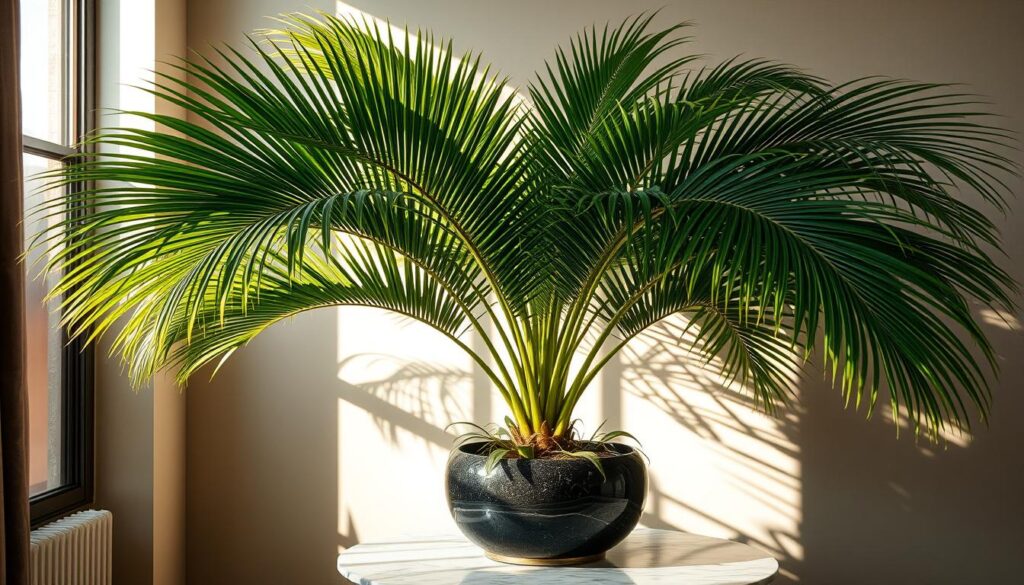
Majesty Palm and Ruffled Fan Palm Insights
The Majesty Palm thrives as a statement piece in sun-drenched rooms. According to The Spruce, it requires bright indirect light and weekly watering to maintain its lush appearance. Position it near east-facing windows where morning sun nourishes without scorching its delicate fronds.
Ruffled Fan Palms offer a compact alternative with pleated leaves that resemble folded paper. ELLE DECOR suggests placing these in bedrooms or offices—their air-purifying qualities and modest size (up to 4 feet tall) suit smaller spaces. Use well-draining soil mixed with sand to prevent root rot.
“Palms introduce organic geometry that complements both contemporary and traditional décors,”
| Variety | Mature Height | Light Needs |
|---|---|---|
| Majesty Palm | 10 ft | Bright indirect |
| Ruffled Fan | 4 ft | Medium light |
Pair palms with trailing varieties like calathea orbifolia for layered greenery. In open-concept homes, position taller specimens behind sofas to define zones. Rotate pots monthly to ensure even growth and dust leaves biweekly for optimal photosynthesis.
Styling Your Space with Large Leaf Arrangements
Transform blank walls into living galleries through strategic foliage placement. Start by clustering specimens with similar soil and light needs—this simplifies care while creating cohesive displays. ELLE DECOR suggests pairing elephant ear’s bold plates with ruffled fan palm’s delicate pleats for contrasting textures that command attention.
Scale matters. Position taller varieties like banana trees behind low-growing types to mimic natural layering. Leave 18-24 inches between pots for airflow and visual breathing room. For narrow spaces, use vertical plant stands to showcase trailing specimens without floor clutter.
“Contrast glossy and matte finishes to add depth—think rubber plant beside calathea,”
| Grouping Strategy | Example Plants | Design Impact |
|---|---|---|
| Texture Mix | Elephant Ear + Ruffled Fan | Dramatic tactile contrast |
| Height Variation | Bird of Paradise + Ferns | Vertical dimension |
| Color Play | Variegated Monstera + Snake Plant | Light-reflective surfaces |
Swap basic pots for woven baskets or ceramic planters to elevate your decor. Rotate arrangements seasonally—move gardening favorites grown outdoors indoors during cooler months. Test layouts using smartphone photos before committing; subtle shifts can dramatically alter room energy.
Remember: rules bend. Start with trusted pairings, then introduce wildcards like staghorn ferns. Your space becomes a canvas where leaves dictate the rhythm—every adjustment reveals new possibilities.
Integrating Big-Leaf House Plants in Modern Interiors
Modern design thrives on balance—where organic shapes meet clean lines. Large-leaf varieties become natural focal points when paired with minimalist furniture and neutral tones. Start by selecting one statement plant per room, like a philodendron with heart-shaped foliage, then build around it.
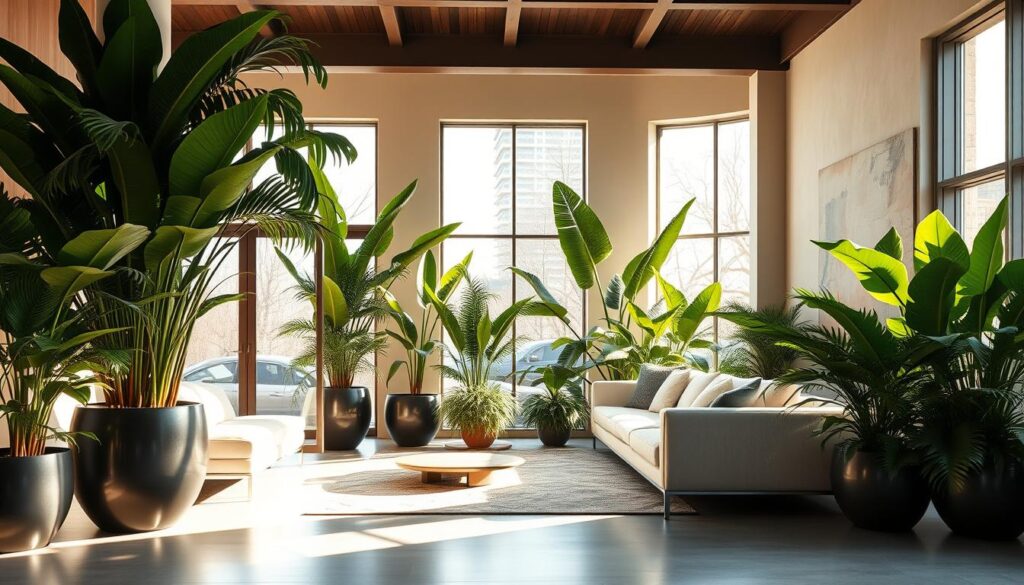
Complementing Other Houseplants and Decor
Contrast glossy leaves with matte surfaces for visual intrigue. Pair the velvety texture of calathea orbifolia beside spiky succulents in concrete planters. This mix of soft and rigid forms creates dynamic tension while keeping care simple—both thrive in medium light.
Scale dictates harmony. A fiddle leaf tree anchors tall spaces, while trailing pothos soften shelves. Follow the “rule of thirds”: place taller specimens in the back third of arrangements, mid-height varieties in the middle, and compact types up front.
“Layering leaf sizes mimics nature’s hierarchy, making interiors feel curated yet organic,”
| Bold Plant | Companion | Design Effect |
|---|---|---|
| Monstera | Air plants | Jungle canopy illusion |
| Rubber Tree | Snake Plant | Vertical vs horizontal lines |
| Bird of Paradise | Peperomia | Tropical meets cottagecore |
Position low maintenance varieties like ZZ plants in dim corners, reserving sunny spots for commonly grown sun-lovers like crotons. Rotate pots monthly to prevent lopsided growth, and use sheer curtains to diffuse harsh afternoon rays.
Expert Tips for the Care and Maintenance of Large Foliage
Mastering plant care starts with understanding their silent language—every droop or brown spot tells a story. Lisa Eldred Steinkopf from The Spruce advises: “Large specimens like fiddle leaf figs demand consistency. Sudden changes in light or watering routines trigger stress signals.”
Professional Care Strategies from Horticulturists
Rotate your tree-sized specimens weekly to prevent lopsided growth. For fiddle leaf varieties, use filtered water at room temperature to avoid shocking delicate roots. Dust leaves monthly with a microfiber cloth—this simple step boosts photosynthesis by 40%.
Prune strategically. Remove yellowing leaves at the base using sterilized shears. “Never cut more than 20% of foliage at once,” warns Steinkopf. Apply diluted liquid fertilizer every 4-6 weeks during spring and summer, pausing in winter.
“Big-leaf houseplants thrive indoors when treated like living sculptures—observe, adjust, and respect their growth patterns.”
| Challenge | Expert Solution | Frequency |
|---|---|---|
| Dry leaf edges | Pebble tray humidity boost | Daily |
| Slow growth | Balanced 10-10-10 fertilizer | Monthly |
| Leaf drop | Stable temperature checks | Weekly |
Adjust watering based on your corner’s light exposure. North-facing areas need 25% less hydration than south-facing spots. For Monstera deliciosa, let soil dry 2 inches deep between waterings.
New plant parents often overcare. Start with two key habits: track growth in a journal and mimic native habitats. Your big-leaf houseplants will reward you with vibrant, show-stopping foliage that transforms any space.
Seasonal Care Strategies for Your Big-Leaf Plants
Your green companions’ needs shift like the weather—master these rhythms to keep foliage thriving year-round. The Spruce notes that 73% of plant stress occurs during seasonal transitions. Proactive adjustments prevent leaf drop and maintain vibrant colors.
Adapting to Changing Conditions
Winter demands restraint: cut watering by 40% for most varieties. Bird of paradise enters dormancy—pause fertilization until spring. Use a humidifier to combat dry indoor air, aiming for 50-60% humidity. Rotate pots weekly to compensate for weaker sunlight.
Summer brings growth spurts. Increase hydration for plants like elephant ear, but avoid soggy soil. ELLE DECOR recommends sheer curtains to filter intense afternoon rays. Move variety grown outdoors temporarily to shaded patios for fresh air.
- Spring: Resume fertilizing with balanced 10-10-10 formula
- Fall: Gradually reduce watering as daylight wanes
- Extreme heat: Mist leaves early morning to prevent scorching
Indoor vs. Outdoor Considerations
Specimens commonly grown outdoors face different challenges inside. Monstera adapts well to controlled environments, while fiddle leaf fig struggles with temperature swings. Outdoor spaces offer natural humidity but risk pest exposure.
| Factor | Indoor Care | Outdoor Care |
|---|---|---|
| Light | Consistent indirect | Variable intensity |
| Water | Measured schedule | Weather-dependent |
| Pests | Rare | Common |
“Transition outdoor specimens gradually—sudden moves shock roots,”
Monitor your home’s microclimates. South-facing windows work winter, but shift eastward come summer. For large leaves, wipe surfaces monthly to maximize light absorption during darker months.
Tailoring Indoor Conditions for Exotic Foliage Plants
Your jungle thrives when air feels like a tropical breeze—moist, warm, and gently moving. The Spruce emphasizes that mimicking native habitats prevents stress-related leaf drop. Start by monitoring humidity with a digital hygrometer, aiming for 60-70% for most tropical varieties.
Humidity, Temperature, and Ventilation Tips
Elephant ear varieties demand consistent moisture in the air. Use pebble trays filled with water beneath their pots or run a cool-mist humidifier nearby. For ruffled fan palms, group them with other specimens to create shared humidity pockets.
Airflow matters as much as moisture. Rotate plants weekly to ensure even exposure and prevent stagnant air. The Spruce advises:
“Strategic placement near open windows or fans prevents fungal issues without drying leaves.”
- Keep temperatures between 65-85°F—avoid drafts near AC vents
- Wipe leaves monthly to maintain transpiration efficiency
- Use oscillating fans on low settings for gentle circulation
| Plant | Ideal Humidity | Temperature Range |
|---|---|---|
| Elephant Ear | 70% | 70-85°F |
| Ruffled Fan | 60% | 65-80°F |
| Fiddle Leaf Fig | 50-60% | 60-75°F |
Adjust watering frequency based on room conditions—closed spaces retain moisture longer. For trees like mature fiddle leaf figs, prune lower leaves to improve airflow around their base. Remember: environment shapes every leaf’s destiny.
Conclusion
Transform your living space into a lush retreat where greenery becomes both art and ally. Bold specimens like the Fiddle Leaf Fig and African mask plant elevate rooms through sculptural forms, while purifying air naturally. Their glossy surfaces catch light, amplifying brightness without harsh glare—ideal for dim corners needing life.
Successful care hinges on three pillars: indirect sunlight, well-draining soil, and mindful watering. Rotate pots weekly to ensure balanced growth, and let soil dry slightly between hydration sessions. Experts recommend grouping humidity-loving varieties like calathea orbifolia to create shared microclimates.
Experiment with arrangements that reflect your style. Pair towering bird of paradise with trailing pothos for layered depth. Seasonal adjustments keep foliage vibrant—reduce water in winter, increase misting during summer heat.
Your journey with these botanical wonders leads to healthier air and striking visuals. Whether starting with one statement piece or curating a garden nook, each addition brings nature’s calm indoors. Ready to expand your collection? Explore trusted resources to help your green companions thrive indoors for years.

